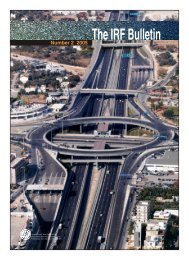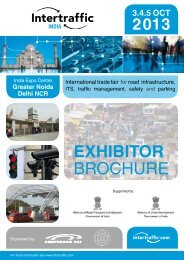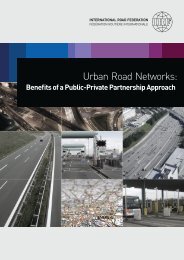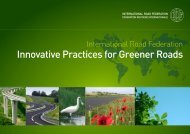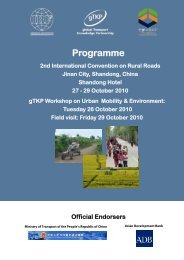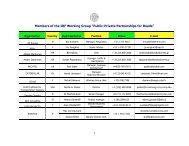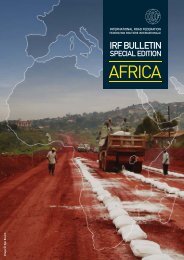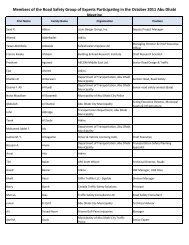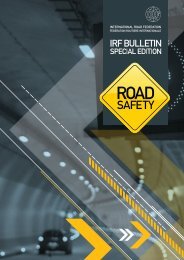TRANSPORT
TRANSPORT
TRANSPORT
- No tags were found...
You also want an ePaper? Increase the reach of your titles
YUMPU automatically turns print PDFs into web optimized ePapers that Google loves.
MANAGEMENT<br />
and State Governments in developing the country’s road<br />
infrastructure to adequate standards. The document<br />
included meticulous strategy proposals for rural connectivity<br />
through all-weather roads. District-wise planning of roads<br />
for all villages with 100 or more inhabitants by the end<br />
of 2010 was undertaken. Table 1 presents the breakdown<br />
of targets for village connectivity by all-weather roads<br />
pursuant to Vision: 2021.<br />
Table-2:<br />
Estimated Road Length and Funds Required for New Connectivity<br />
as per PMGSY Norms<br />
Habitation<br />
Population<br />
Group<br />
1000+<br />
Number of Rural<br />
Unconnected<br />
Habitations<br />
59,855<br />
Length<br />
Required<br />
(Km)<br />
133,949<br />
Table-1:<br />
Vision: 2021 – Targets for Connectivity of Villages<br />
500-999<br />
250-499<br />
81,466<br />
31,451<br />
161,955<br />
69,901<br />
Villages (population categories) to be<br />
connected by all-weather roads<br />
Target Year<br />
Total<br />
172,772<br />
365,805<br />
Villages with population above 1000<br />
Villages with population between 500-1000<br />
Villages with population below 500<br />
2003<br />
2007<br />
2010<br />
Source: Final Report; Working Group on Rural Roads in the 11th Five-year Plan;<br />
Planning Commission, Govt. of India<br />
were to be connected through 365,000 km of new road<br />
connectivity (Table 2).<br />
Source: Final Report; Working Group on Rural Roads in the 11th Five-year Plan;<br />
Planning Commission, Govt. of India<br />
The Target<br />
By the end of 1999, it was estimated that the length of rural<br />
roads to be built was 1.162 million kilometres, for ensuring<br />
connectivity of 0.29 million villages. At the outset of the<br />
new Millennium, the Government of India constituted a<br />
National Rural Road Development Committee (NRRDC)<br />
to ensure connectivity of all rural habitations. The status<br />
showed that almost all villages with a population of over<br />
1,500 were already connected; about 86% of villages<br />
with 1,000–1,500 inhabitants and 43% of villages with a<br />
population of less than 1000 were connected by all-weather<br />
road facilities. However, ensuring 100% connectivity of<br />
villages, as per Vision: 2021, clearly necessitated a phased<br />
approach. Accordingly, a special rural road development<br />
programme, known as ‘Pradhan Mantri Gram Sadak<br />
Yojana’ (PMGSY) was launched in December 2000, with<br />
the objective of connecting the remaining unconnected<br />
habitations in a phased manner. The unit for connectivity<br />
was changed from ‘village’ to ‘habitation’ 1 in order to<br />
provide more people with accessibility. It was planned to<br />
connect all habitations with populations of 500 and above<br />
in plain regions, and of 250 and above in hilly, desert and<br />
tribal areas. At the time of the programme launch, about<br />
330,000 habitations, out of a total of 825,000, were<br />
lacking all-weather accessibility. However, in accordance<br />
with a detailed survey undertaken, the government finally<br />
declared that about 173,000 unconnected rural habitations<br />
Achievements of the Five phases of PMGSY<br />
The period of implementation of the five phases of the<br />
PMGSY scheme (up to 2005) fell mostly within the<br />
Government of India’s 10th Five-Year Plan (2002-2007).<br />
Thus, an estimate of the connectivity status available for<br />
the year 2006 provides some insights into the degree of<br />
implementation. It showed that, out of a total of 172,772<br />
habitations, a mere 33% of approvals for connectivity had<br />
been granted. In reality, however, only around 16% of<br />
the targeted habitations had been connected through allweather<br />
roads. The details of these habitations from the<br />
perspective of population are given in Table 3.<br />
Population<br />
Category<br />
1000 & above<br />
500 & above<br />
250 & above<br />
Total<br />
Table-3:<br />
Connectivity Status under PMGSY (as at October 2006)<br />
No. of<br />
Eligible<br />
Habitations<br />
59,855<br />
81,466<br />
31,451<br />
172,772<br />
No. of<br />
Habitations<br />
covered<br />
by project<br />
approved<br />
28,361<br />
21,942<br />
6,335<br />
56,638<br />
No. of<br />
Habitations<br />
Connected<br />
16,081<br />
8,602<br />
2.620<br />
27,303<br />
Source: Final Report; Working Group on Rural Roads in the 11th Five-year Plan;<br />
Planning Commission, Govt. of India<br />
IRF BULLETIN SPECIAL EDITION: RURAL <strong>TRANSPORT</strong>, VOLUME-2 | 29



